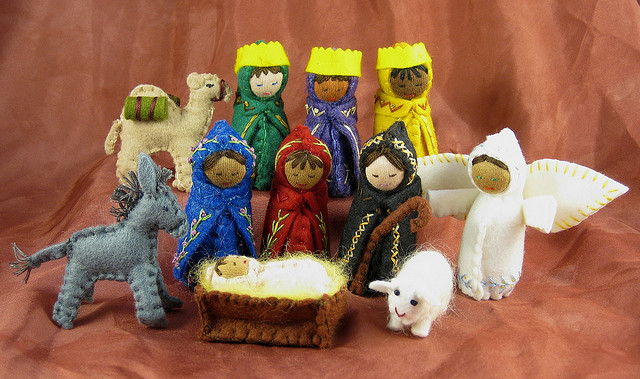 Also Psalm 147:1-20; Jeremiah 31:7-14; Ephesians 3:1-14
Also Psalm 147:1-20; Jeremiah 31:7-14; Ephesians 3:1-14
The Crèche Without A Fence
The twelfth day of Christmas falls on a Sunday this year. This Sunday, January 5th, is the second Sunday of the Christmas season. It is also the last Sunday of the Christmas season.
Time to move on?
Today’s object is a crèche scene.
A typical crèche scene includes the Holy Family, a few animals, shepherds and interloping wise men. They arrive a bit later in the Christmas story, but they add color!
The gospel lesson today is John’s account of the Christmas story. John likes to get to the point. Forget the earthly drama. Get to the God part of the story. Shepherds, sheep, donkeys, angels, Mary and Joseph—that’s for other evangelists to tell.
John is in a hurry.
In the beginning was the Word, and the Word was with God, and the Word was God. He was in the beginning with God. All things came into being through him, and without him not one thing came into being. What has come into being in him was life, and the life was the light of all people.
The birth of Jesus with all the details are less important to John. He had personal ties to the Holy Family, but he just refused to get distracted. Jesus was always with God from the beginning.
John makes it clear from the start, that when Jesus came into the world, he came for all people. The rest of the book of John builds on this. It is a favorite book of missionaries. It is also the focus of modern Messianic Jews.
While you talk about the Christmas story as told by John you can be putting away the figures of a crèche scene. As you wrap each figure in tissue and place it in a box, you might address how each one is missing in the John account.
There is one thing missing in both the typical crèche scene AND the book of John.
A fence.
The stable with its typical cast is too confining for John. John has no need to corral the characters of the Christmas Story. In John’s view, focusing on all of this is missing the point.
John’s focus is on relationship.
His life is the light of all people.
Tie in the other lectionary readings.
You might switch the Psalm reading and the Old Testament reading today for the dramatic build. First was God’s relationship with the “chosen” and then his continued relationship through history.
Psalm 147 talks about God’s love for the chosen people.
Jeremiah talks about the return of the scattered people of Israel. God will bless them.
In Ephesians. Paul makes it clear that all people are part of the redemption story. They, too, will be blessed.
John will quickly leave the birth of Christ and introduce us to the cast of characters that proves that Christ came for all people—the wedding guests in Cana, the woman at the well, the priestly Nicodemus, the blind man, and even dead Lazarus and his family. The book of John will cover a lot of bases.
As you put away the manger, mention that crèche scenes never include a fence. Jesus was born into a free-range farmyard.
